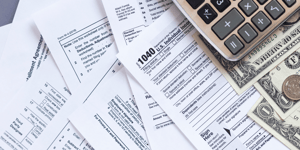
Sunset on Summer: Simple Steps for a Tax-Ready Fall
Although it may seem like tax season only just ended, the end of summer is an ideal time for taxpayers to review their own income and withholding for the upcoming tax year.
All too often, taxpayers are surprised to learn that they owe taxes or may even face penalties as a result of underpayment throughout the year. Depending on the amount owed and any applicable interest and fines, taxpayers could find themselves facing financial stress.
The good news? This can usually be avoided with a simple tax checkup.
Who Should Review Their Tax Withholding?
All taxpayers should take the time to review their withholding at least once during the year. However, those who are especially prone to underpayment and other withholding mistakes include those who earn income that's not already subject to tax withholding. This is common for 1099 workers, such as independent contractors and freelancers who are responsible for paying their own estimated taxes each quarter.
Likewise, those earning income through a side hustle should take the time to review their own tax situations and ensure they're setting aside enough to cover what they owe.
Finally, those who have experienced a major life change (such as a new job or even a divorce) should review their taxes and withholding to avoid unwanted surprises come tax time.
What Needs to Be Done?
Performing a tax checkup is relatively straight-forward. For those who are W2 employees, simply taking the time to review their W-4s and ensure that they are claiming the correct number of exemptions. If too many exemptions are improperly claimed, this could lead to underpayment through withholding and thus owing more money when it comes time to file a tax return.
For those who are newly working gig jobs or have taken on a side hustle where their taxes are not automatically withheld, the IRS Tax Withholding Estimator tool can be an excellent resource. In order to use this tool, taxpayers should keep the following documentation on-hand:
- A copy of the most recent year's tax return
- Paystubs for any jobs
- Information about other income (including self-employment income)
Using this tool, it is possible for taxpayers to estimate their federal income tax withholding and see how their refund may be affected by their current withholding amount. From there, taxpayers can get a better idea as to the estimated withholding amount that is most suitable for them to avoid owing taxes come filing time.
After using the Tax Withholding Estimator, taxpayers who need to change their withholding should do so on their W-4 form (if working for an employer). For those working as freelancers or independent contractors, it's important to set aside money with each payment received and pay estimated taxes on at least a quarterly basis.
Estimated taxes must be paid any time a taxpayer expects to owe $1,000 or more by the time they file their tax return. Failure to make estimated taxes could result in underpayment penalties and interest at the end of the tax year. The quarterly payment dates for estimated taxes are typically in January, April, June, and September of each year.
Avoid Penalties and Surprises Come Tax Season
Dealing with tax withholding can be complicated, especially for those who have recently experienced a major life change and aren't sure whether (or how) their tax liability will be affected by it. Meanwhile, with more people taking on gig work with income that's typically not subject to automatic withholding, it can be difficult figuring out the logistics of paying quarterly estimated taxes.
Nobody wants to face an unexpected tax bill, let alone underpayment penalties and interest come tax time. This is why it's so important to conduct a basic tax checkup, ideally towards the end of the summer. From there, taxpayers can make any necessary adjustments to their withholding or start making quarterly estimated tax payments to ensure they're paying the proper amount.
Contact a Tax Advisor
Taxpayers who are still confused or unsure of what to do next should consult with a tax advisor or financial advisor for further guidance. From there, they can receive the personalized assistance they need to make sure they have all their bases covered and won't face unexpected bills when it comes time to file their tax returns.
To learn more about LGT and how we can serve you, contact us here.



